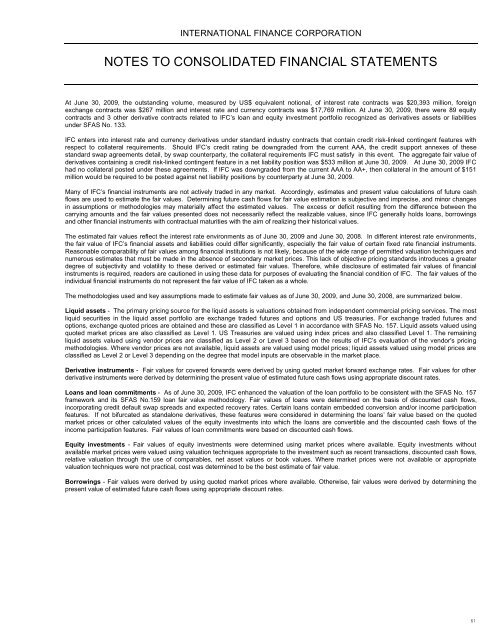Volume 2 - IFC
Volume 2 - IFC
Volume 2 - IFC
Create successful ePaper yourself
Turn your PDF publications into a flip-book with our unique Google optimized e-Paper software.
INTERNATIONAL FINANCE CORPORATION<br />
NOTES TO CONSOLIDATED FINANCIAL STATEMENTS<br />
At June 30, 2009, the outstanding volume, measured by US$ equivalent notional, of interest rate contracts was $20,393 million, foreign<br />
exchange contracts was $267 million and interest rate and currency contracts was $17,769 million. At June 30, 2009, there were 89 equity<br />
contracts and 3 other derivative contracts related to <strong>IFC</strong>’s loan and equity investment portfolio recognized as derivatives assets or liabilities<br />
under SFAS No. 133.<br />
<strong>IFC</strong> enters into interest rate and currency derivatives under standard industry contracts that contain credit risk-linked contingent features with<br />
respect to collateral requirements. Should <strong>IFC</strong>’s credit rating be downgraded from the current AAA, the credit support annexes of these<br />
standard swap agreements detail, by swap counterparty, the collateral requirements <strong>IFC</strong> must satisfy in this event. The aggregate fair value of<br />
derivatives containing a credit risk-linked contingent feature in a net liability position was $533 million at June 30, 2009. At June 30, 2009 <strong>IFC</strong><br />
had no collateral posted under these agreements. If <strong>IFC</strong> was downgraded from the current AAA to AA+, then collateral in the amount of $151<br />
million would be required to be posted against net liability positions by counterparty at June 30, 2009.<br />
Many of <strong>IFC</strong>’s financial instruments are not actively traded in any market. Accordingly, estimates and present value calculations of future cash<br />
flows are used to estimate the fair values. Determining future cash flows for fair value estimation is subjective and imprecise, and minor changes<br />
in assumptions or methodologies may materially affect the estimated values. The excess or deficit resulting from the difference between the<br />
carrying amounts and the fair values presented does not necessarily reflect the realizable values, since <strong>IFC</strong> generally holds loans, borrowings<br />
and other financial instruments with contractual maturities with the aim of realizing their historical values.<br />
The estimated fair values reflect the interest rate environments as of June 30, 2009 and June 30, 2008. In different interest rate environments,<br />
the fair value of <strong>IFC</strong>’s financial assets and liabilities could differ significantly, especially the fair value of certain fixed rate financial instruments.<br />
Reasonable comparability of fair values among financial institutions is not likely, because of the wide range of permitted valuation techniques and<br />
numerous estimates that must be made in the absence of secondary market prices. This lack of objective pricing standards introduces a greater<br />
degree of subjectivity and volatility to these derived or estimated fair values. Therefore, while disclosure of estimated fair values of financial<br />
instruments is required, readers are cautioned in using these data for purposes of evaluating the financial condition of <strong>IFC</strong>. The fair values of the<br />
individual financial instruments do not represent the fair value of <strong>IFC</strong> taken as a whole.<br />
The methodologies used and key assumptions made to estimate fair values as of June 30, 2009, and June 30, 2008, are summarized below.<br />
Liquid assets - The primary pricing source for the liquid assets is valuations obtained from independent commercial pricing services. The most<br />
liquid securities in the liquid asset portfolio are exchange traded futures and options and US treasuries. For exchange traded futures and<br />
options, exchange quoted prices are obtained and these are classified as Level 1 in accordance with SFAS No. 157. Liquid assets valued using<br />
quoted market prices are also classified as Level 1. US Treasuries are valued using index prices and also classified Level 1. The remaining<br />
liquid assets valued using vendor prices are classified as Level 2 or Level 3 based on the results of <strong>IFC</strong>’s evaluation of the vendor's pricing<br />
methodologies. Where vendor prices are not available, liquid assets are valued using model prices; liquid assets valued using model prices are<br />
classified as Level 2 or Level 3 depending on the degree that model inputs are observable in the market place.<br />
Derivative instruments - Fair values for covered forwards were derived by using quoted market forward exchange rates. Fair values for other<br />
derivative instruments were derived by determining the present value of estimated future cash flows using appropriate discount rates.<br />
Loans and loan commitments - As of June 30, 2009, <strong>IFC</strong> enhanced the valuation of the loan portfolio to be consistent with the SFAS No. 157<br />
framework and its SFAS No.159 loan fair value methodology. Fair values of loans were determined on the basis of discounted cash flows,<br />
incorporating credit default swap spreads and expected recovery rates. Certain loans contain embedded conversion and/or income participation<br />
features. If not bifurcated as standalone derivatives, these features were considered in determining the loans’ fair value based on the quoted<br />
market prices or other calculated values of the equity investments into which the loans are convertible and the discounted cash flows of the<br />
income participation features. Fair values of loan commitments were based on discounted cash flows.<br />
Equity investments - Fair values of equity investments were determined using market prices where available. Equity investments without<br />
available market prices were valued using valuation techniques appropriate to the investment such as recent transactions, discounted cash flows,<br />
relative valuation through the use of comparables, net asset values or book values. Where market prices were not available or appropriate<br />
valuation techniques were not practical, cost was determined to be the best estimate of fair value.<br />
Borrowings - Fair values were derived by using quoted market prices where available. Otherwise, fair values were derived by determining the<br />
present value of estimated future cash flows using appropriate discount rates.<br />
61
















